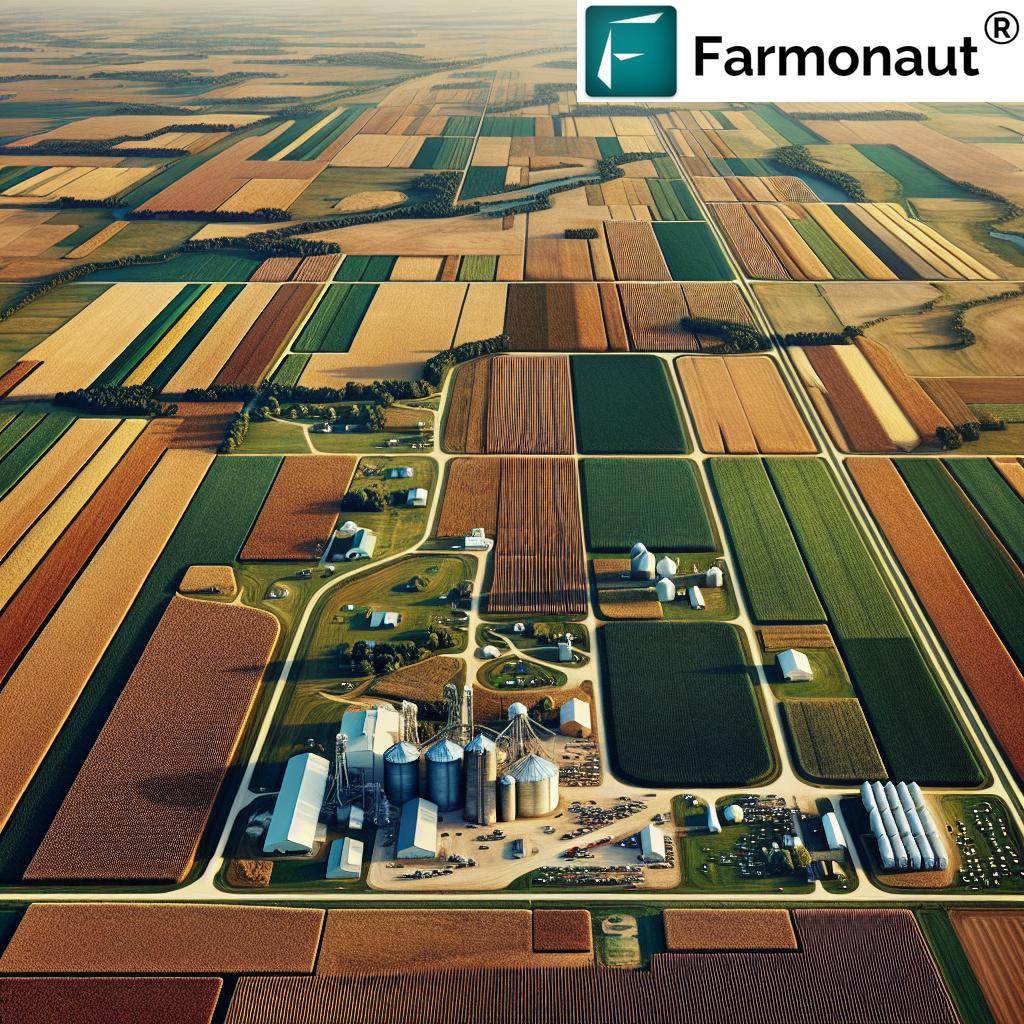Almond Yield: 7 Proven Soil & NDVI Tips for California
“California almonds can yield up to 2,000 pounds per acre with optimized soil nutrients and precise irrigation scheduling.”
Introduction: Unlock High Almond Yields With Soil & NDVI Mastery
Are you looking to elevate almond yield in your California orchards, navigate unpredictable soil and climate conditions, and maximize your return with the latest scientific agronomic techniques? The path from almond cultivation to successful harvest hinges on understanding changes in soil, canopy, water status, and timely application of resources. In this comprehensive guide, we explore the interplay between NDVI data, nutrient management, irrigation, phenological stages, weed/pest risks, and yield estimation—combining expert resources, Californian guidelines, and actionable steps tailored for 2025 and beyond.
Whether you’re new to almond farming or an experienced grower seeking a data-driven edge, discover how satellite-driven advisories—like those powered by Farmonaut—can revolutionize orchard management. From Marion County to the central valleys of California, these methods are proven, scalable, and ready to empower your next bumper crop season.
“Almond orchards using NDVI data see up to 20% improvement in yield estimation accuracy over traditional visual checks.”
Reduce carbon footprint in your Californian almond orchards using Farmonaut’s Carbon Footprinting solution. Track emissions, improve sustainability, and comply with environmental regulations while optimizing yield and soil health.
California Almond Cultivation: Basics
California leads the world in almond cultivation, producing over 80% of the global supply. Almonds thrive due to the state’s Mediterranean climate—mild, wet winters and hot, dry summers. Yet, achieving top yields (1,900–2,000 kg/acre or ~2,000 lbs/acre) requires a razor-sharp focus on soil parameters, irrigation scheduling, and interpreting NDVI trends at every phenological stage.
- Key Regions: Central Valley (Fresno, Kern, Stanislaus, and Marion County)
- Crop System: Perennial tree crop, usually managed in large commercial blocks.
- Harvest Period: Typically August-September (confirmed by UC ANR publications)
- California Guidelines: Refer to UC publications, CDFA Healthy Soils Program, and Almond Board resources.
Yield and health vary significantly across soil types, irrigation methods (typically drip), and seasonally fluctuating water/moisture conditions. Data-driven management bridges these gaps.
Almond Phenological Stages Explained
Almond cultivation in California is defined by regular, predictable phenological stages. Each stage determines optimal soil composition, irrigation, nutrient rate, and appropriate NDVI value ranges.
- Dormancy (October–February): Trees are at rest, minimal activity, low NDVI (0.1–0.3).
- Bud Swell & Bloom (February–March): Vegetative activity begins, NDVI starts to rise (0.3–0.5).
- Leaf Out, Fruit Set (April–May): Canopy development, strong NDVI increase (0.4–0.7).
- Hull Split (July–August): Fruit development, peak NDVI (0.7–0.9), water demand maximal.
- Harvest (August–September): Canopy senescence, NDVI decrease (0.4–0.6), yield estimation window.
- Post-Harvest: Trees transition to dormancy, NDVI declines further (0.2–0.4).
NDVI and soil health both change through the year—knowing the expected range at each stage lets you act proactively, prevent losses, and maximize almond yield.
Phenological Stage-wise Yield Optimization Table for California Almonds
| Phenological Stage | NDVI Value Range | Recommended Soil Parameters (pH/EC/Moisture) | Irrigation Strategy | Nutrient Application (N-P-K per acre) | Common Pests/Diseases | Estimated Yield Impact (%) |
|---|---|---|---|---|---|---|
| Dormancy | 0.1 – 0.3 | pH 6.0–7.0, EC <1.7, Moisture low |
Minimal to none—monitor for winter drought | Not recommended (tree not actively uptaking) | N/A (monitor for winter rots) | 0 (maintenance) |
| Bud Swell / Bloom | 0.3 – 0.5 | pH 6.5, EC ~1.0, Soil moist, not saturated |
Begin supplemental (drip) irrigation | N: 20–25 kg P: 15–20 kg K: 150–180 kg |
Brown rot, blossom blight | +10–15 |
| Leaf Out / Fruit Set | 0.4 – 0.7 | pH 6.5, EC 1.0–1.2 Field capacity |
Regular (drip), 4–5 mm/day | N: 25–28 kg P: 17–22 kg K: 170–180 kg |
Aphids, Alternaria leaf spot, mites | +20–25 |
| Hull Split | 0.7 – 0.9 | pH 6.0–6.8, EC 1.0, Ample moisture |
Daily, adjust for ET & stress, 7–8 mm/day | K: 180–220 kg; N/P as required | Navel orangeworm, hull rot risk | +15–20 |
| Harvest | 0.4 – 0.6 | pH 6.5, Low EC, Reduced moisture for shakers |
Reduce or stop pre-harvest (to ease harvest) | None (nonsensitive stage) | Hull rot, ants, navel orangeworm | Yield finalization |
| Post-Harvest | 0.2 – 0.4 | pH 6.5, Increase SOC with covers, Minimize EC |
Light irrigation to maintain root viability | Organic matter (compost), no NPK | Shot hole borer, weed flush risk | Next season setup |
1. Optimal Soil Health Management for High Yield
Why Soil Management Underpins Every Almond Harvest
The health and composition of soil directly dictates almond growth, canopy vigor, resistance to pests, and ultimately, yield. Almonds are particularly sensitive to pH, organic matter (SOC), salinity, and nutrient balance. Poor soil health or mismanagement leads to stress, weak growth, and low returns—even in otherwise favorable regions like California or Marion County.
- pH: Maintain 6.0–7.0. Deviations reduce nutrient availability and uptake.
- Salinity: EC <1.7 dS/m is favorable. Higher EC (especially in arid or irrigated soils) causes toxicity and leaf burn.
- Soil Organic Carbon (SOC): Aim for >1.0% SOC. Current data for California often shows critical SOC <0.25%—necessitating cover crops, organic amendments, and reduced tillage.
Action Plan to Improve Soil Health
- Conduct soil testing before and after harvest to determine current pH, EC, and nutrient status.
- If pH is low <6.0 or high >7.0, amend using lime (low pH) or sulfur (high pH), as per UC ANR recommendations.
- To increase SOC and structure, annually add cover crops, compost, or animal manure (organic approach).
- Monitor salinity continuously—especially in arid or long-term irrigated soils—and leach salts if EC creeps up.
- Implement drip irrigation systems for localized nutrient and water delivery, reducing general salt buildup and improving water efficiency.
For advanced monitoring, our Farmonaut platform tracks soil health from satellite, providing early alerts on salinity, moisture, and organic matter trends for almond growers in California and beyond.
Want to understand your orchard’s environmental impact? Use Farmonaut’s carbon footprinting tool—get actionable data for CDFA, supply chain, and regenerative farming requirements.
2. Balancing Soil pH and Salinity in California Almond Orchards
NDVI and Yield are Highly Sensitive to Soil pH and Salinity
According to California Department of Food and Agriculture (CDFA) and UC ANR, soil pH must be monitored between 6.0 and 7.0 during all stages, with ideal yield realized within this window. Salinity (conductivity) impacts water and nutrient uptake; almond trees are sensitive to EC >1.7 dS/m, especially in arid and Mediterranean regions.
- Field practice: Use gypsum for high sodium, manage EC via annual soil testing, apply fresh water in the post-harvest or dormant stage if available.
- NDVI data: Soil salinity and improper pH manifest as localized low NDVI values (<0.4 during vegetative peak), indicating stress, stunted trees, or premature leaf senescence.
- Recent findings: Many California almond orchards trend alkaline due to irrigation water EC and prior fertilizer applications.
Diagnostic Tips
- Track soil pH and EC before bloom, post-harvest, and after irrigation cycles to catch issues early.
- Relate NDVI trends to soil test results: if NDVI is consistently low in a zone, investigate pH/EC first.
Precision soil management ensures the orchard’s productive lifespan and high annual yields even when neighboring regions face constraints due to salinization or depleted organic carbon.
3. Precise Irrigation Practices Based on NDVI for Almond Yield
Water stress, even for short periods, reduces almond yield, impairs kernel quality, and triggers premature leaf drop (senescence), showing up as NDVI declines in satellite images. California almond orchards depend on drip irrigation (recommended), with timing and frequency tightly synchronized to real NDVI/NDWI data.
- NDVI-based triggers: Declining NDVI in an otherwise healthy stage can signal water deficit long before visual symptoms appear. NDWI (Normalized Difference Water Index) pinpoints canopy and soil moisture shortfalls.
- General guidelines:
- Pre-bloom to nut-fill: 4–8 mm/day (adjusted for ET and soil holding capacity)
- Pre-harvest (late August–September): Reduce/stopped to harden hull, allow smooth shaker operation
- Post-harvest: Light, infrequent irrigation keeps roots healthy, prevents undue drought stress
- Irrigation is best applied before visible canopy wilt—ideally triggered by “moderate” NDVI or NDWI drops at specific growth stages.
- Timing: Water between 05:00–09:00am to minimize evaporation.
Tip: Schedule your system using precision NDVI data from Farmonaut’s app or web interface for maximum efficiency.
Optimize almond orchard machinery and irrigation fleet with Farmonaut’s fleet management solution for better logistics and reduced costs.
4. Using NDVI Data for Almond Yield Estimation
How NDVI and NDWI Drive Data-Based Yield Prediction
Satellite indices NDVI (Normalized Difference Vegetation Index) and NDWI (Normalized Difference Water Index) are the gold standard for quantifying tree health, canopy cover, real-time stress, and ultimately, yield expectations. In California, NDVI data is now considered more reliable than traditional visual checks, delivering up to 20% more accurate yield forecasts (as per recent advisory data and publications).
- NDVI & Harvest: Typical range at harvest is 0.4–0.6 (canopy senescence lowers NDVI). Values above this range post-harvest often indicate weed flush or residual vegetation.
- Sustained NDVI above 0.7 during nut fill and hull split stages signals excellent canopy health and maximum yield potential.
- Sharp NDVI drops between early September and harvest (per advisory period data) mark active harvesting and leaf loss.
- Interpreting NDVI Data:
- Low NDVI (below stage range): May imply stress due to moisture deficit, salinity, pest/disease, or nutrient shortages.
- High NDVI: At times outside active growth, it could signal weed outbreaks, requiring targeted management actions.
- Application: Use NDVI trends throughout the season, not just one-off snapshots, for superior accuracy. Farmonaut’s traceability solution ensures supply chain honesty and data-driven confidence in harvest records.
Example: The expected yield per acre (from advisories in 2025) ranged from 1,900–2,050 kg/acre, corresponding with high-harvest NDVI values.
Note: NDVI is sensitive to both crop type and phenological stage. Use typical NDVI ranges for almonds at each development point for correct interpretation and zone-appropriate management.
5. Nutrient Management Strategies for Each Growth Stage
Optimal nutrient composition at each stage powers almond yield: In California, soil N (nitrogen), P (phosphorus), K (potassium), S (sulfur), and Zn (zinc) must match stage-based sufficiency ranges. Data published by UC ANR and Western Fertilizer Handbook forms the backbone of nutrient guidelines.
- Nitrogen (N): 18.2–27.3 kg/acre (harvest/post-harvest). At fruit set, canopy demand rises—apply in splits as tree enters active growth.
- Phosphorus (P): 13.7–22.8 kg/acre throughout vegetative and reproductive stages. Early application optimizes root development and initial fruit set.
- Potassium (K): 136.5–182.0 kg/acre at fruit development; critical for kernel fill and shell strength.
- Sulfur (S): 9.1–18.2 kg/acre—necessary for protein synthesis, applied as needed based on soil test.
- Zinc (Zn): 0.9–2.7 kg/acre—crucial for leaf development and fruit retention.
- Application Method: Drip fertigation (preferred in California) for N, K, and S; soil or foliar for Zn. No fertilizer recommended during harvest and post-harvest (not a nutrient-responsive stage).
All rates above are based on healthy, mature orchards in typical California almond regions. Critical nutrient gaps (as noted in advisory data: e.g., low N, P, K, S, Zn) must be closed early in the season—affecting kernel weight, shell split, and final yield.
Organic vs Chemical Fertilizers
- Organic: Compost, manure, legume cover crops—recommended for long-term soil organic carbon and biological health.
- Chemical: Urea (N), Superphosphate (P), Potassium sulfate/chloride (K), Gypsum (S), Zinc sulfate (Zn)—precise, fast, and stage-targeted.
- TIP: Do NOT apply fertilizers during dormancy, harvest, or post-harvest (per recent advisories), to prevent leaching, inefficiency, and unnecessary salinity buildup.
6. Pest, Weed & Disease Control with NDVI
Smart, Data-Driven Risk Monitoring for Almond Yield Preservation
- Pests/Diseases in California: Navel orangeworm (NOW), hull rot, Alternaria, ants are predominant threats at harvest/post-harvest. Earlier, Aphids and mites can attack during active canopy growth.
- Weeds (e.g., Bermudagrass, Field Bindweed) thrive in sparse canopy zones, often identified by spatially variable low NDVI.
- NDVI Application:
- Localized NDVI “holes” (0.1-0.3 during vegetative peak): check weed presence, pest/disease stress, or water deficit.
- Rapid NDVI changes pre/post-harvest: confirm via scouting and implement targeted chemical or organic interventions (glyphosate spot-spray, mulch cover, canopy pruning, orchard sanitation).
-
Management:
- Preemptively apply fungicide or biocontrols (as per UC guidelines) where data shows persistent NDVI stress coinciding with historical risk periods.
- Regularly monitor post-harvest for shot-hole borers and weed outbreaks (rapid green-up in NDVI despite dormancy or senescent crop).
Proactive NDVI use enables orchard managers to intervene early, preserve yield, and prevent crop loss in both typical and challenging years.
7. Accurate Harvest Timing & Yield Estimation
Harvest scheduling and yield prediction are the culmination of year-round management:
- Monitor NDVI for signals of canopy senescence and leaf drop—the best time to initiate shaking and nut pickup.
- NDVI drops from peak to 0.4–0.6 indicate optimal harvest period. Sharp dips may signal active harvest or localized stress.
- Yield estimation: Use multi-date NDVI series rather than single readings for robust projections.
- Combine NDVI/Nutrient/Irrigation data—e.g., when NDVI anomalies match areas of low N, P, or high EC, expect reduced yields and direct additional management (if early enough).
- Leverage Farmonaut’s AI-powered advisory tool for science-backed harvest predictions customized for your orchard’s unique NDVI signatures and resource status.
- If you need almond crop insurance or loan eligibility verification: Farmonaut’s satellite-based verification system is recognized as a credible resource by lenders needing credible, post-2021, and onward data.
Key Yield KPIs: (California 2025)
- Commercially significant almond yields: 1,900–2,000 kg/acre (per stage-specific NDVI and nutrient status)
- NDVI at Harvest: 0.4–0.6 indicates a healthy senescing canopy; values below 0.3 imply stress/damage and risk yield reduction of up to 30%.
- Best yield estimation windows: Harvest week(s) (August–September), validated by NDVI drop and kernel moisture sampling.
Farmonaut Satellite Technology for California Almond Farms
Farmonaut is a leading satellite technology company dedicated to delivering actionable, data-driven insights for modern agriculture. Here’s how we support almond growers in California and similar Mediterranean and arid regions:
- Satellite NDVI & NDWI maps: Monitor vegetation (canopy) health, detect irrigation shortfalls, and schedule orchard operations efficiently.
- Real-time AI Advisory: In-app, web, and API-based advisories factoring in soil status, phenological stage, and stress indicators for scientifically-backed recommendations.
- Traceability with Blockchain: Enable transparent almond crop origin and supply chain verification—meeting California and international quality demands for commercial buyers.
- Resource management tools: Cut operational costs with fleet and input management features optimized via satellite data.
- Advanced field and farm management: For large-scale, multi-block operators, our large-scale farm management system centralizes all your NDVI, irrigation, soil, and advisory needs in one dashboard.
- APIs for integration: Farmonaut API | Developer Docs
FAQ: Almond Yield & NDVI Optimization
Q1: What is the optimal NDVI range for healthy almonds during harvest in California?
A: At the harvest stage, a healthy, mature orchard in California typically records NDVI values between 0.4 and 0.6, as per UC ANR guidelines and satellite data from 2021 onward.
Q2: What soil pH and salinity are best for maximizing almond yield?
A: Soil pH should remain between 6.0 and 7.0 with EC (salinity) below 1.7 dS/m for ideal nutrient uptake and for maintaining high yield and healthy tree development.
Q3: When should nutrient fertilizers be applied to almonds for best yield?
A: Nutrient fertilizers (especially N, P, K, S, Zn) are best applied at the start of active growth (bud swell, bloom, early fruit set); hold off during dormancy, harvest, or post-harvest stages. Split fertigation during the growing season synchronizes nutrient uptake with canopy/vigor demand.
Q4: How does NDVI help in managing almond orchard irrigation?
A: NDVI and NDWI detect canopy stress due to insufficient moisture before visual symptoms arise, allowing for irrigation to be adjusted precisely and preventing yield reduction due to drought or overwatering.
Q5: Which are the most critical pests/diseases at harvest in California almonds?
A: Navel orangeworm (NOW), hull rot, and ants are the key threats during harvest, as confirmed by recent advisories; control measures should be intensified as harvest approaches, with regular NDVI monitoring for stress or unexpected green-up (weed flush).
Q6: How can we use Farmonaut’s satellite-based platform to boost almond yield?
A: Our satellite technology offers accurate, timely NDVI/NDWI data, AI-driven advisories for soil and pest management, water scheduling, and traceability—all accessible via web, mobile app, or API to support every operational need from small orchards to large-scale agribusiness.
Q7: Can yield estimation accuracy really improve using NDVI? By how much?
A: Yes—satellite-based NDVI tracking can boost yield estimation accuracy by up to **20%** compared to visual estimation, as corroborated by both academic studies and advisory data.
Conclusion: Future-Proof Your Almond Yield with Soil, NDVI, and Smart Data
Involving both time-tested agronomic guidelines and cutting-edge satellite technology is the proven route to consistent, commercial almond harvest success in California’s evolving climate. From soil health and balanced pH, to laser-precise irrigation and data-led NDVI tracking, each link in the management chain must align with crop phenological stages and local soil/water conditions.
Almond yields exceeding 2,000 lbs/acre are realistic, provided growers adopt rigorous soil monitoring, optimal irrigation, targeted fertilizer application, early pest/weed detection, and reliable NDVI analysis. By leveraging Farmonaut’s satellite-based products, almond producers in California and similar regions can boost yield, minimize risk, and lead the world in sustainable, data-driven crop production.
Ready to get started?
Want to integrate NDVI, soil and yield data with your own systems? Learn more at the Farmonaut API page and find advanced information for developers via the API Developer Docs.












